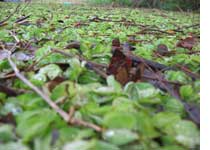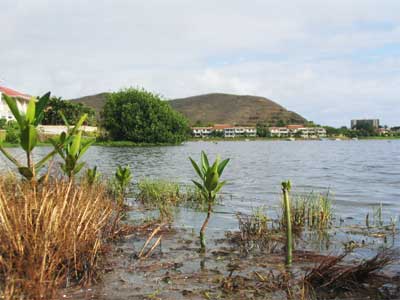Mangroves
Mangrove is an invasive non-indigenous species introduced to the estuary through the City’s drainage canals. The State Forestry and Wildlife master plan for the Kailua Waterways includes removal of all mangroves from the system. While mangroves play an important role in their natural ecosystems in other areas of the world, in Hawaii they are alien invasive species with few supportive environmental aspects.
In their natural range, mangroves act to support an entire community of other species in a stable ecosystem. In Hawaii, most of these community species are absent — although two of the most common animals found in Hawaii mangroves include the Samoan crab and the Australian mullet.
Leaf litter and shading cause a buildup of highly organic an anaerobic benthic substrate. Yellow tanic acid from the bark of the mangroves leach into the waters and inhibit the growth of natural Hawaiian invertebrates. Mature trees provide nesting rounds for egrets and night herons (neither of which are endangered) who pey on endangered waterfowl chicks. These birds dececate into the already anaerobic nutrient-rich sediments below.
A major focus of work on the lake has been the removal of mangroves.
 Salvinia molesta
Salvinia molesta
Salvinia molesta, which cost million of dollars to remove from Lake Wilson, and now is infesting Kawainui Marsh, was first officially reported in Hawaii at Kaelepulu Pond.
Fortunately, vigilant lake residents identified the problem and quick action on the part of volunteers and the State Department of Fish and Wildlife eliminated the plant from the lake. The salvinia molesta infestation was concentrated in the wetland area where salinities are low. The higher salinity in the rest of lake helped prevent this alien fern from spreading.
Bullfrogs
Bullfrogs were brought into Hawaii as an aquaculture venture. While the venture failed, the bullfrogs were quite successful and in some bird preserves on Oahu, they are now the primary predator of Hawaiian Stilt chicks. Bullfrogs are found in the fresh water stream that flows into Kaelepulu wetland. They are being actively trapped at the wetland, with an average of six captured every month.
Resources:
Weed threatens several ponds, Honolulu Advertiser, 2-3-2003
Lingle places priority on lake, Honolulu Advertiser, 2-8-2003
Kailua gears up to fight salvinia, Honolulu Advertiser, 2-16-2003
